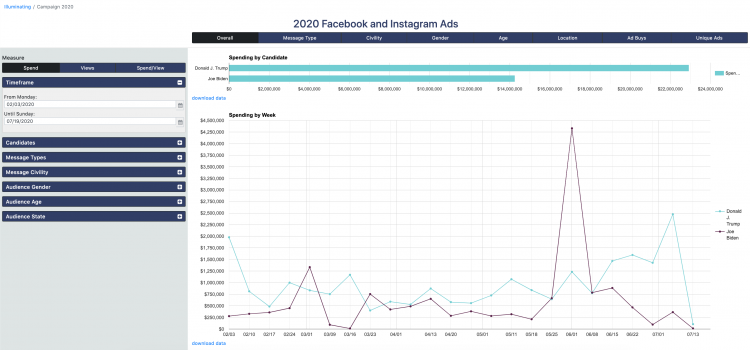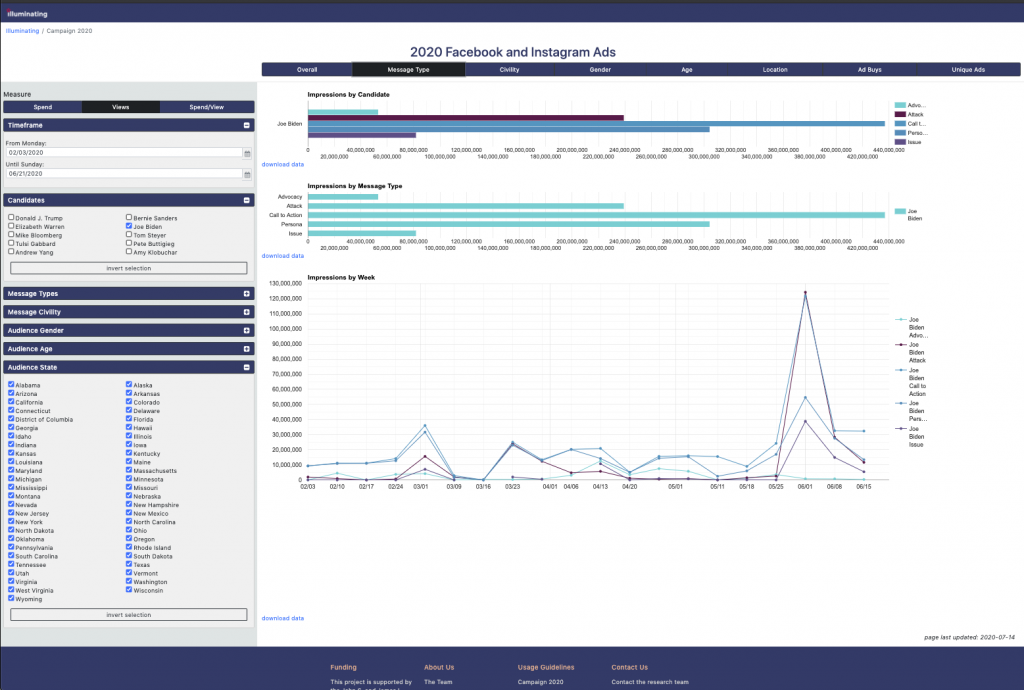
By Anthony Dabbundo
As American politics sees a continued expansion into digital campaigning through social media posts and advertisements, there’s still a lack of transparency and knowledge about how campaigns attempt to reach out to and persuade voters using digital ads and posts.
Barack Obama’s and Donald Trump’s campaigns both used digital outreach as a way to micro target voters and win U.S. Presidential elections. But the methods that the campaigns used to reach these voters largely went hidden and were opaque throughout the campaign.
Media outlets typically provide plenty of coverage of the typical television ad spending and other more traditional forms of campaigning. These outlets, however, have often focused less on what campaigns are doing online despite the growing reliance on digital advertisements, social media posts, and other digital tactics by campaigns. Part of the reason for this lack of focus is just how difficult it is for journalists to track what campaigns are doing online. Up until very recently, major technology companies did not provide the public with much information about political advertising on their platforms.
In 2018, Facebook released its Ad Library to provide information on the ads being run on both Facebook and Instagram. But just because journalists and the public now have access to the Facebook advertisement library, Illuminating project lead Dr. Brian McKernan said, doesn’t mean that it’s easy to navigate or that conclusions can easily be made from thousands of political advertisements.

“If you ever spend any time on the (Facebook) ad library, you’ll see hundreds of the same ads,” project lead Dr. Jennifer Stromer-Galley said. “It’s very hard to get your arms around the different kinds of ads. It’s hard to get a bigger picture of who the campaigns are targeting.” Stromer-Galley says it’s “very hard to see what the range of political ads are for websites like Facebook and Instagram,” without a way of taking a step back and looking at all of the compiled data together.
“Journalists don’t find the Facebook ad library to be incredibly useful,” McKernan said. “When you go there, it’s too hard to navigate and it doesn’t frame things in a way that journalists find helpful. “
The Illuminating project synthesizes data from the Facebook ad library and presents it in a way which journalists can easily tap into who politicians are targeting, how they are reaching them and how much money they are spending to do so. By tracking both the Democratic primary and now the general election campaign in 2020, Illuminating breaks down the Facebook and Instagram ads by each of the key players. Illuminating uses data compilation and visualization to filter ads by topic and type, and show which ads are most viewed by age group, gender, and location.
The 2020 version of the Illuminating project is funded and supported by the John S. and James L. Knight Foundation, the Tow Center for Digital Journalism at Columbia University, and the Center for Computational and Data Sciences at Syracuse University.
Instead of just knowing that a candidate spent a certain amount of dollars to run a certain ad, the Illuminating project informs us about who each specific ad is targeted to and whether it was an attack ad on the opposition, or a call to action from the base voters.
The Illuminating team of 22 active members, including Syracuse University professors, PhD students, Masters students and 11 undergrads. The team uses a computational approach known as supervised machine learning to classify the message types and topics present in the thousands of relevant ads the team has collected from the Facebook Ad Library.
To do so, the team first manually classifies a sample of the ads by message type, for example attack, advocacy or call to action, and by message topic, for example health, immigration, or COVID-19. The message type team uses the results of this manual classification to train machine learning algorithms on how to accurately classify the advertisements, while the topic team uses a lexicon approach to identify specific words that signal the ad topic.
The idea for this project began in 2014, Stromer-Galley said, and first launched its website during the 2016 campaign for President. Illuminating tracked 31 different candidates and filtered their Facebook messages and Twitter posts by topic and type. In 2020, the project has expanded to include Facebook and Instagram ads.

The Illuminating data allows the ability to notice patterns and changes in how candidates address their constituents and potential future voters over time and the course of a campaign. If candidates are spending millions of dollars to reach voters through the digital space through micro-targeting, then someone needs to improve transparency and hold them accountable, Stromer-Galley said. Members of the team have even begun to notice patterns of speech that are unique to certain candidates.
“Over time, I’ve been able to realize that people generally speak in the same tone all the time, or speak in the same words all the time,” Julia Howard-Flanders, a rising senior at SU and member of the topic team said.
PhD student and topic team lead Ania Korsunska said that there are subtle, yet noticeable differences in how candidates communicate with certain subgroups of voters that can’t necessarily be seen by scrolling through Facebook posts or ads.
McKernan said: “It helps journalists make sense in a fast, interactive way in what otherwise would be a very complicated set of metadata.”

good post! what is the main reason you write this on your blog?
Thank you! This is the blog of the Illuminating Project, https://illuminating.ischool.syr.edu/. This post is meant to describe the project and give a general overview of how we collect and categorize data.